5 Presentation Techniques Presidents Use to Impact an Audience [Featuring Inauguration Speeches]
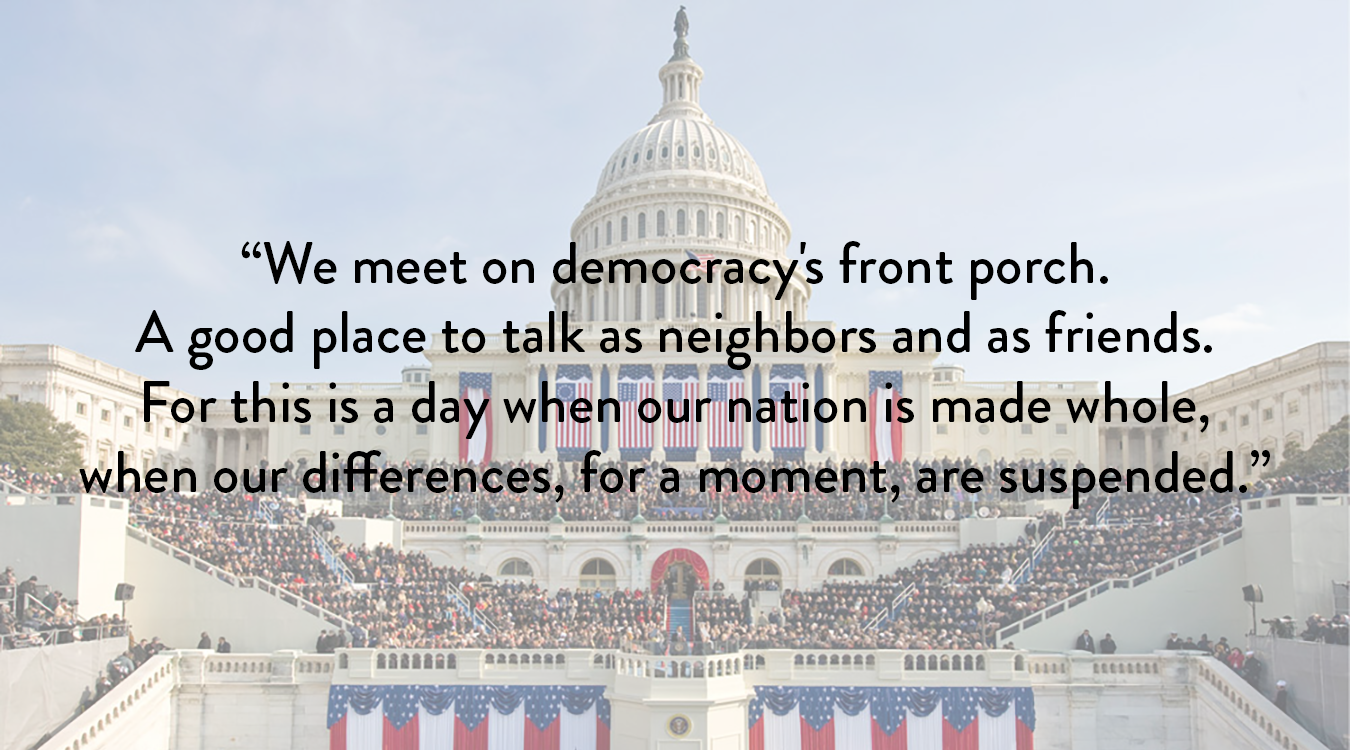 Today, our nation will say farewell to President Obama as he completes his eight-year service and passes the mantel to Donald Trump. And Trump will address the nation as President Trump for the first time. Inauguration day is a tradition that began with the birth of our nation, and the inaugural address is the most important of traditions, only second to the oath of office. After months and sometimes years of campaigning, promises made, and hands shaken, the inaugural address is the moment when the elected president sets the tone for his presidency.
Today, our nation will say farewell to President Obama as he completes his eight-year service and passes the mantel to Donald Trump. And Trump will address the nation as President Trump for the first time. Inauguration day is a tradition that began with the birth of our nation, and the inaugural address is the most important of traditions, only second to the oath of office. After months and sometimes years of campaigning, promises made, and hands shaken, the inaugural address is the moment when the elected president sets the tone for his presidency.
We analyzed inaugural addresses from Washington to Obama, and chose the five most effective and efficient speeches from the modern era based on simplicity of message, call-to-action, emotional resonation, body language, and tone.
Creating a Big Idea Through Simplicity of Message:
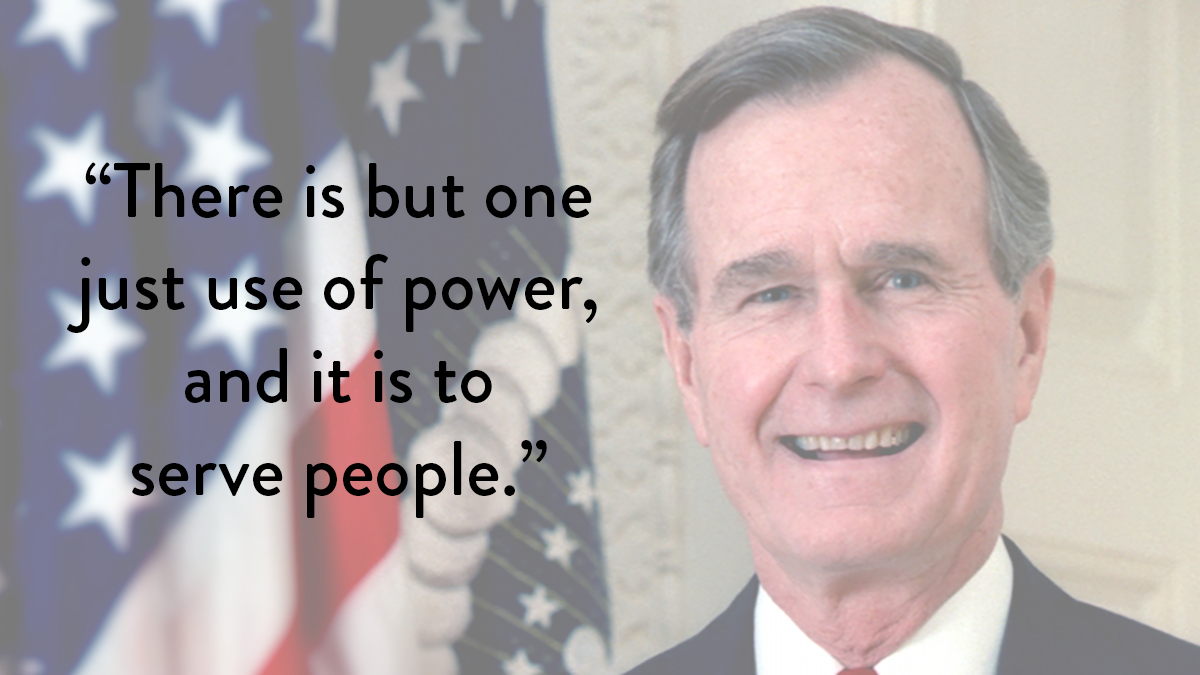 George H W Bush, January 20, 1989
George H W Bush, January 20, 1989
An effective speech is constructed on the foundation of a big idea, the purpose of the speech, that is strengthened throughout the speech with simple repetition. For a presidential inauguration, the big idea, or purpose, is the incoming president’s vision for the next four years and the principles on which this vision is based.
In 1989, George Bush, Sr. addressed the nation with a sermon-like approach, promoting altruism and a strong reassertion of our national roots in a changing world. His big idea is grounded in morality, unity and selflessness, and national tradition in the face of change. These ideas are represented through metaphor that Bush repeats often. He relates American democratic traditions to words and books first by referring to the long tradition of the oath of office: “I’ve just repeated word for word the oath taken by George Washington 200 years ago, and the Bible on which I placed my hand is the Bible on which he placed his.”
He segues from our long history to the idea of unity and humanity: “We meet on democracy’s front porch. A good place to talk as neighbors and as friends. For this is a day when our nation is made whole, when our differences, for a moment, are suspended.” Bush, Sr. envisions our nation’s history and traditions as a story that must be sustained and reasserts the idea of unity and loving our fellow man. To introduce morality in connection with humanity, he follows with a prayer. “Make us strong to do Your work, willing to heed and hear Your will, and write on our hearts these words: ‘Use power to help people’.” With his big idea and metaphors in place, he continues to utilize them throughout the speech:
Bush does not make direct reference to Christian morality, but the message resonates his prayer from the beginning of the speech: “America is never wholly herself unless she is engaged in high moral principle. We as a people have such a purpose today. It is to make kinder the face of the Nation and gentler the face of the world.” All of these ideas culminate to his presidential promise to the American people: “There is but one just use of power, and it is to serve people.”
He closes by connecting all the dots of his big idea, and revisiting the allusions created to relate to those ideas: “But I see history as a book with many pages, and each day we fill a page with acts of hopefulness and meaning. The new breeze blows, a page turns, the story unfolds. And so, today a chapter begins, a small and stately story of unity, diversity, and generosity — shared, and written, together.” Every assertion about democracy and the future of our nation is united in the end to leave the audience with the big idea presented from the beginning of the speech. The use of metaphor helps the audience follow the purpose and central message of the speech all the way to the end.
Takeaways: Every speech should be built on a big idea, a purpose, the why of the speech. The big idea should be repeated often to maintain the audience’s understanding. Metaphors are useful tools to create simple and relatable ideas.
Engaging the American People With a Call to Action:
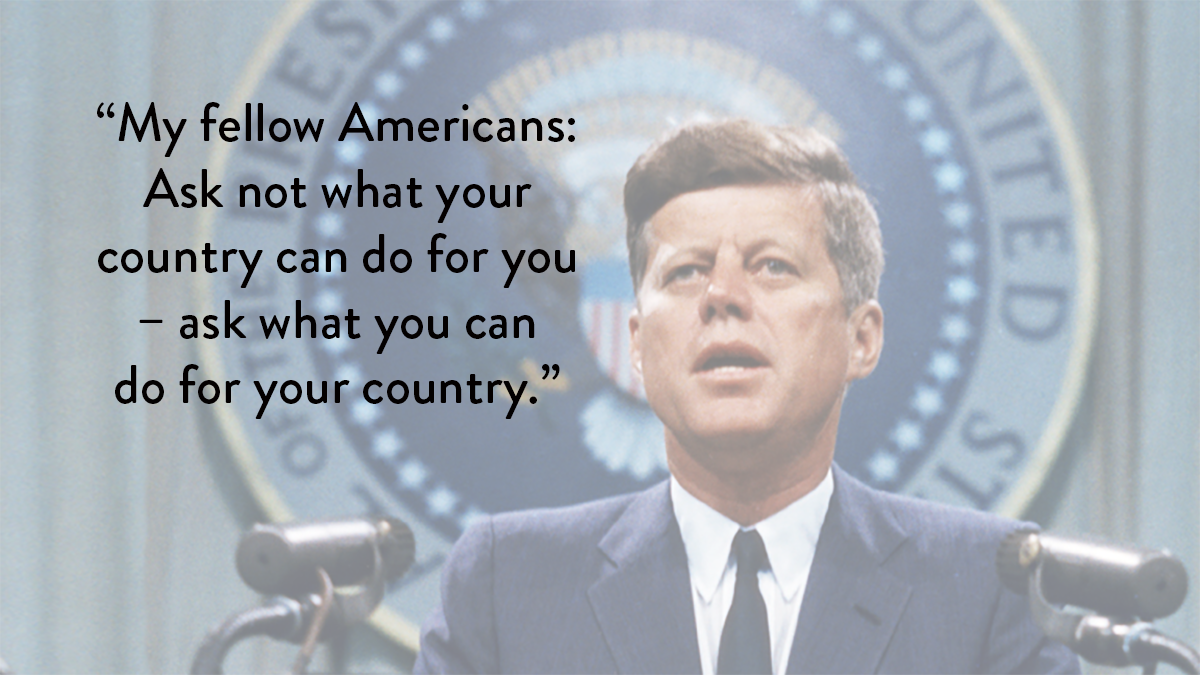 John F Kennedy, January 20, 1961
John F Kennedy, January 20, 1961
Hand in hand with the main idea is the call to action. A speech is most effective when the audience is challenged to engage with the message and the speaker’s argument. The most memorable quotes from inaugural speeches come from presidents who challenge the American people to reassess their beliefs and take action.
John F Kennedy’s 1961 inaugural address accomplished more with brevity and concise language than most accomplished in much longer speeches. Kennedy’s most quoted line is of course, “My fellow Americans: Ask not what your country can do for you – ask what you can do for your country.”
There were many obstacles for Kennedy to overcome in the minds of the American people. Kennedy was, at 43, the youngest president, and the first Catholic president. He was taking office during the tragedies of the Vietnam War. He not only represented a shift in the status quo of the presidency, he was the face of the new America, the youthful generation of men and women who were now adults taking control of the country.
His call to action challenged an idealistic generation to continue to serve their country after having already been sacrificed by the older generation to the Vietnam War. His call to action is repeated throughout his speech, but the most famous line embodies everything he wanted to impart on the American people.
Takeaway: A speech should not tell the audience what they already know. Build a call to action on the foundation of your big idea that challenges your audience to participate in your message long after your speech is over.
Emotionally Resonating Storytelling Incites a Stronger Response:
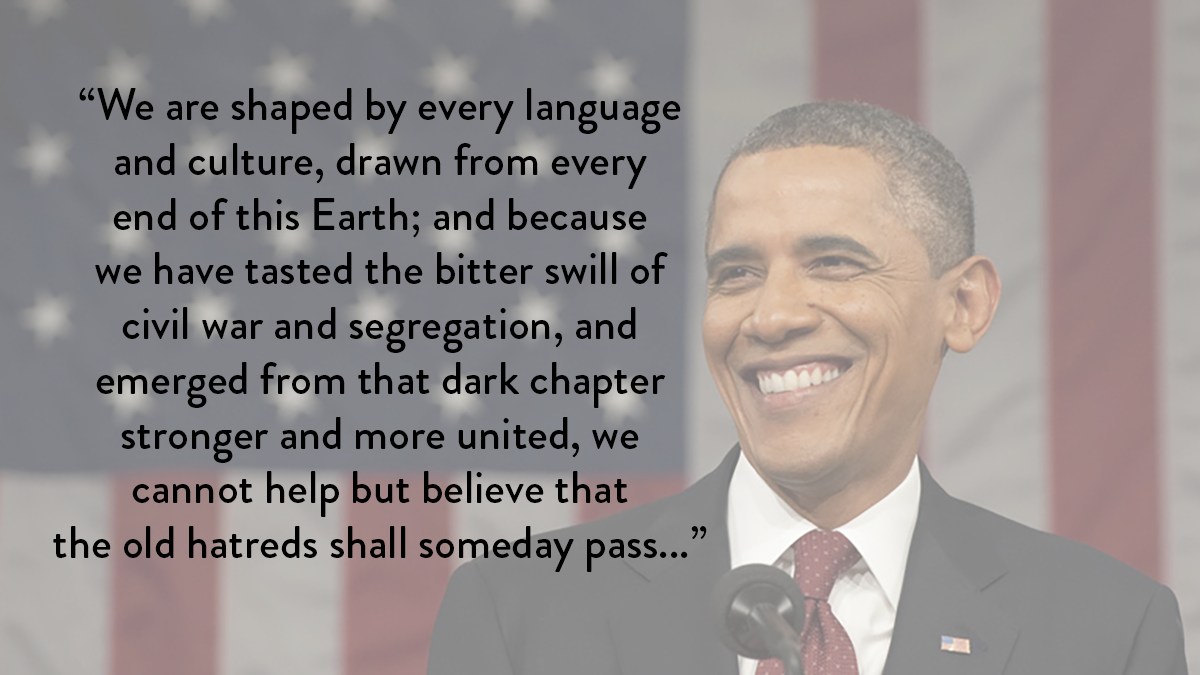 Barack Obama, January 20, 2009
Barack Obama, January 20, 2009
Speakers who weave narrative throughout their speeches instead of just spouting bullet points are the most effective in conveying their message. Our brains are wired for story. We make sense of our world through the narrative of experience. In this sense, presidents who acknowledge and pay homage to American history while also offering hope for the future are the best storytellers. Obama’s first inaugural address masterfully utilizes the narrative of American history to address the landmark event of his own election into office. He invokes history as both a call-to-action and as reason to move forward. Obama’s narrative is the story of America: “My fellow citizens: I stand here today humbled by the task before us, grateful for the trust you have bestowed, mindful of the sacrifices borne by our ancestors.”
Every good story has a hero, a villain, a conflict, and a resolution. Obama is not the hero; the voters and citizens of America are the heroes. The villain is not American history, but the desire to live in the past. The conflict in his narrative is not between the two parties, not even between the previous administration. Instead, he posits that some of the conflicts such as the Iraq War, were unavoidable, and others such as the poor economy are “collective failure[s].” His resolution is simply that America is changing for the better, and our differences are actually the strengths of our country: “We are shaped by every language and culture, drawn from every end of this Earth; and because we have tasted the bitter swill of civil war and segregation, and emerged from that dark chapter stronger and more united, we cannot help but believe that the old hatreds shall someday pass…”
He focuses on the basis of American political and patriotic rhetoric, freedom and equality: “The time has come to reaffirm our enduring spirit; to choose our better history; to carry forward that precious gift, that noble idea, passed on from generation to generation: the God-given promise that all are equal, all are free, and all deserve a chance to pursue their full measure of happiness.”
This historical pursuit of our nation is the plot of his speech. Every instance of history he references is about the greater good, but clearly evokes the struggles our nation and its people have endured to accept equality, and thus, finally elect an African American for president. He does not aim to divide white versus black, but doesn’t shirk the darker realities of our forefathers, and specifically African American forefathers: “For us, they toiled in sweatshops and settled the West; endured the lash of the whip and plowed the hard earth.”
To create an emotional appeal, he spotlights his own family history to demonstrate that our history and our nation are still young and that the past is not far behind, but the social climate is changing: “This is the meaning of our liberty and our creed — why men and women and children of every race and every faith can join in celebration across this magnificent mall, and why a man whose father less than sixty years ago might not have been served at a local restaurant can now stand before you to take a most sacred oath.”
In his closing, he again pays homage to American history, quoting a line from Washington himself that embodies the American spirit and establishes a responsibility to the future: “Let it be told to the future world…that in the depth of winter, when nothing but hope and virtue could survive … that the city and the country, alarmed at one common danger, came forth to meet [it].”
Obama utilizes this quote to offer a happy ending to the story, and carries the torch of responsibility to future generations: “America. In the face of our common dangers, in this winter of our hardship, let us remember these timeless words. With hope and virtue, let us brave once more the icy currents, and endure what storms may come. Let it be said by our children’s children that when we were tested we refused to let this journey end, that we did not turn back nor did we falter; and with eyes fixed on the horizon and God’s grace upon us, we carried forth that great gift of freedom and delivered it safely to future generations.”
Takeaway: Utilize the elements of good storytelling (plot with a hero, villain, conflict, and resolution) to create a speech that provides your audience with a clear, emotionally relatable narrative.
Body Language Tells a Story that Aligns with the Message
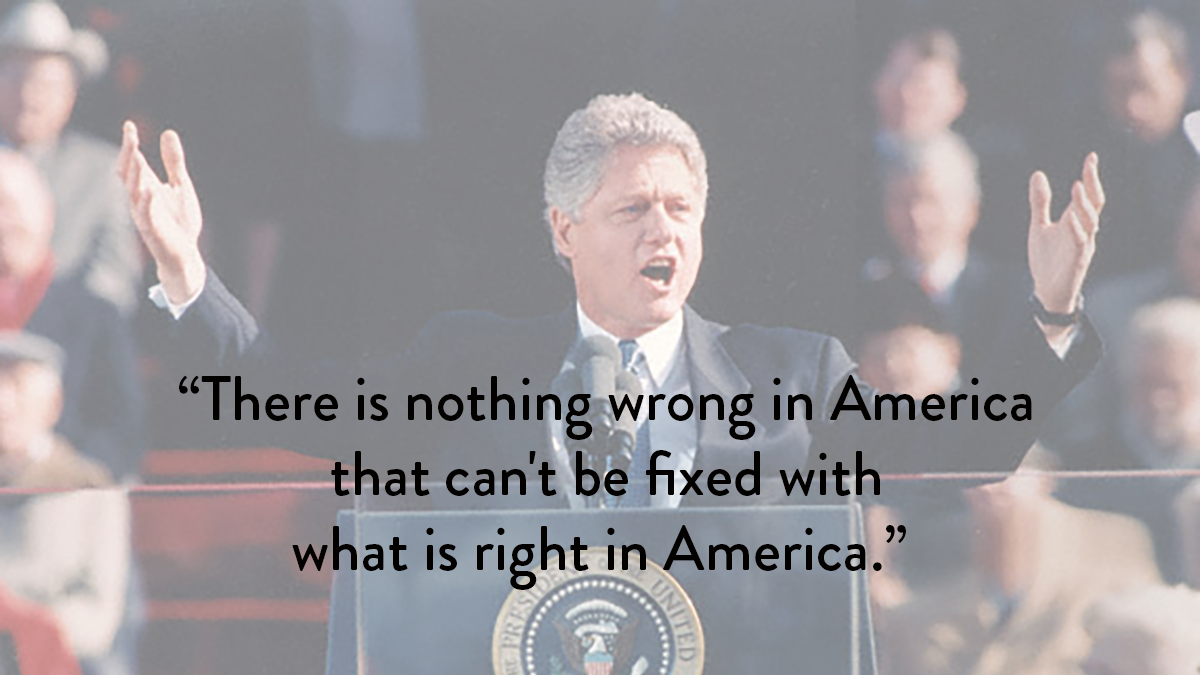 Bill Clinton, January 20, 1993
Bill Clinton, January 20, 1993
Body language tells another story, so stage presence is just as important as the words in the speech. As a speaker, Bill Clinton has been described as cool, calming, attentive, and charismatic. He’s the master of using pauses and silence to emphasize a point, simplifying complex details so the general population can understand, and overall engaging audience members to listen. What should also be noted is his ability to utilize body language to subtly emphasize his points and likability.
In his first inauguration speech, notice as Clinton uses his hands when he lists points, smiles when he challenges the audience to show that a future together is bright, and makes a hammer gesture when he wants to emphasize a point. He also keeps an open posture that conveys genuineness and authenticity – never a closed posture. These body language tactics are used sparingly in this particular speech but are powerful when displayed.
This usage of body language along with rhetoric that is simple such as “There is nothing wrong in America that can’t be fixed with what is right in America,” exude confidence and authority. Despite speaking in front of voters who were skeptical at the time of political change, his warmness and message positively resonates in the body language and facial gestures of those around him.
Keep in mind the power of what body language can do to influence those around you.
Takeaway: Hand gestures can be used to emphasize points in critical points of your speech, especially in call to actions and listing points. Also know when to smile and keep a serious face in a presentation to convey emotion. Too much body language can be overwhelming, but timing your facial response and hand gestures to certain points can build the aura of confidence and authenticity.
Tone Creates Cohesion Between the Message and Delivery
 Ronald Reagan, January 20, 1981
Ronald Reagan, January 20, 1981
The tone of a speech is reflected in careful word choice, sentence structure, and organization of information. If the tone, or style, of the information contradicts the intended purpose of the speech, the audience will misunderstand the message. In his first inaugural address, Ronald Reagan crafts his tone to hold the American government accountable for its failures: “In this present crisis, government is not the solution to our problem; government is the problem. From time to time we’ve been tempted to believe that society has become too complex to be managed by self-rule, that government by an elite group is superior to government for, by, and of the people.”
While his message is that government is broken, his challenge is to still create and strengthen trust and faith in government. He does this with tone. He doesn’t backtrack from holding the government responsible. Instead he re-establishes the purpose of government with the idea of self-rule as the basis: “Now, so there will be no misunderstanding, it is not my intention to do away with government. It is, rather, to make it work — work with us, not over us; to stand by our side, not ride on our back. Government can and must provide opportunity, not smother it.”
Without careful use of tone, Reagan’s address could have come across as a complete defamation of the American government and a call to abolish government. However, the tone is a call to action, a message of hope, and a message of a change in the powers of government.
Takeaway: Careful word choice, structure, and organization of a message are just as important as the message itself. Craft your speech so the tone represents, not contradicts, the intended purpose of the message.
There are many lessons we can learn from our presidents, past and future. We hope our analysis of each of these five inaugural addresses help you build and shape your own speech or presentation.
Follow our ThreeSixtyEight blog here and follow us on Twitter.
Have any questions, comments, or suggestions on what you believe are the best inauguration speeches? Let us know at hq@localhost. And don’t forget to check out our book The Big Fish Experience for more presentation tips – or subscribe to our blog to stay updated on the latest presentation, design, video, and creative trends.
PSST! For tips on web, video, digital strategy, and company culture, check out the newly launched blog of our parent company ThreeSixtyEight here.



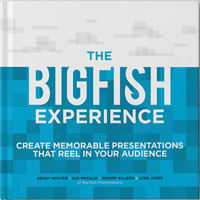
Share your opinion.